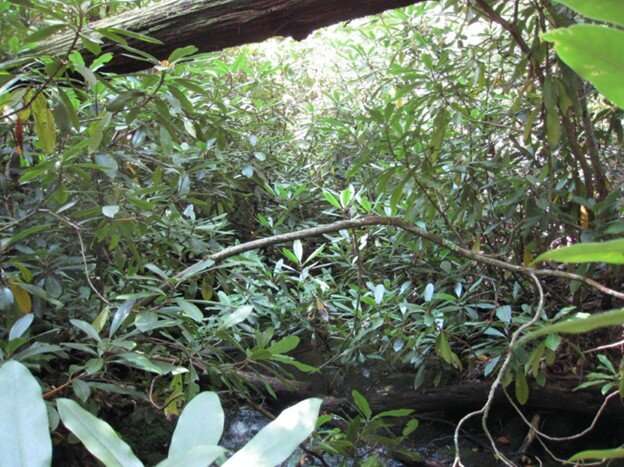Seeing the forest for the shrubs in southern Appalachia

As ecosystems respond to human activity, what species will emerge as new trailblazers, shaping the diversity and resilience of these changing environments? And how can land managers identify these species early on to better prepare for the future?
The forests of southern Appalachia have a history fraught with human activity. Hardy and towering, American chestnut and eastern hemlock once dominated the riparian forests of the region as foundation species, providing essential stability and resources.
However, a shift from long-maintained native land management practices toward Western practices of logging and fire suppression, combined with the introduction of invasive pathogens and pests, dramatically reduced the influence of both trees.
U.S. National Science Foundation-funded Coweeta Long-term Ecological Research site scientist Maura Dudley and her collaborators argue in the journal Forest Ecology & Management that Rhododendron maximum, a tall shrub in forest understories, could be the newest plant to emerge as a foundation species in these ecosystems. Unlike its predecessors, this one may stick around for longer in these changing forests.
Foundation species are widespread, abundant organisms that have lasting effects on many aspects of an ecosystem—from large-scale processes such as carbon cycling to microscopic communities in the soil. Dudley and co-authors found that Rhododendron fulfilled all the traits of a foundation species.
Rhododendron covers approximately 30 million hectares (more than 74 million acres) of southern Appalachian forests, greater than the area of all five Great Lakes. Its thick, outspreading branches and bountiful evergreen leaves provide unique habitat and food for common mammals such as skunks and deer and for more unusual organisms such as slime molds and rare plants.
Its structure shades the understory, reducing photosynthesis and the growth of other plants and seedling trees. Its leaves affect the entire ecosystem; their acidity and low nutrient content reduce decomposition and nutrient availability in both the forests and streams over which Rhododendron branches weave.
"This is a clear example of how ecological systems can reset, with species that had been 'sitting on the bench' now playing key roles," says Doug Levey, a program director in NSF's Division of Environmental Biology. "It also reminds ecologists that forest shrubs are important, despite being overshadowed."
More information: Maura P. Dudley et al. Rethinking foundation species in a changing world: The case for Rhododendron maximum as an emerging foundation species in shifting ecosystems of the southern Appalachians, Forest Ecology and Management (2020). DOI: 10.1016/j.foreco.2020.118240
Journal information: Forest Ecology and Management
Provided by National Science Foundation


















